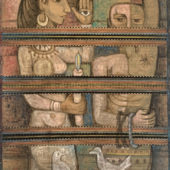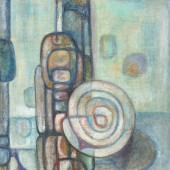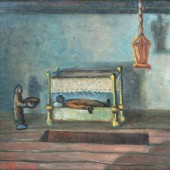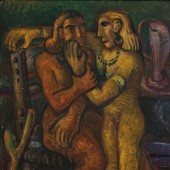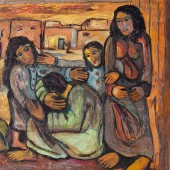Samir Rafi
- Country: Egypt
- Exhibitions:
- A Century in Flux
- RE: Orient
- Taking Shape
- The Short Century
The oeuvre of Samir Rafi is manifold and captivating. The artist represented Egyptian daily life, but also metaphysical and deeply universal themes, repeatedly infused with surrealism and symbolism. Rafi was mentored from an early age by prominent artists such as Shafik Rizk and Angelo de Riz, and later by Saad El Khadem and Hussein Bicar, among others. After attending secondary school under the eminent art educator Hussein Youssef Amin, Rafi graduated at the top of his class in the Decorative Arts Department from the School of Fine Arts in 1948.
Exhibiting with the Art et Liberté group in 1945, he later became a founding member of the Contemporary Art Group with his mentor Amin. During the 1940s and 1950s, Rafi received critical acclaim from artists such as Ramses Younan, poet George Henein and art critics such as the Cairo-based Lebanese Aimé Azar and the Belgian Count d’Arschot who discovered his work at the Egypte-France exhibition at the Pavillon de Marsan in Paris in 1949.
Rafi received a scholarship from the Egyptian government to pursue doctoral studies in art history at the Sorbonne and left for Paris in 1954, where he also joined the studio of André Lhote in 1958. His studies were interrupted in 1964 when he was invited by the president of independent Algeria, Ahmed Ben Bella, to become the Fine Arts Adviser in the Department of Cultural Affairs of the Algerian Ministry of National Education. His time there was both prosperous with significant positions held and critically acclaimed exhibitions, and tumultuous as he was incarcerated after the coup d’état of 1965. Back in Paris in 1968, an ailing Rafi lived a quiet life where he continued to paint, exhibit and write until his death in 2004.
Text by Mehri Khalil
Related artists by country
- Ahmed Askalany
- Adam Henein
- Chant Avedissian
- Fathi Afifi
- Fathi Hassan
- George Bahgory
- Ghada Amer
- Huda Lutfi
- Khaled Hafez
- Lara Baladi
- Abdel Hadi El Gazzar
- Ahmed Moustafa
- Raafat Ishak
- Susan Hefuna
- Youssef Nabil
- Gazbia Sirry
- Ragheb Ayad
- Seif Wanly
- Omar El Nagdi
- Hamed Nada
- Kamel Moustafa
- Kareem Lotfy
- Mahmoud Said
- Mohammed Naghi
- Nermine Hammam
- Youssef Kamel
- Hazem Mahdy
- Ayad Al Nimar
- Mohammed Ismail
- Adel El Siwi
- Adham Wanly
- Guirguis Lotfy
- Hussein Bicar
- Inji Efflatoun
- Kamel El Telmesani
- Khaled Zaki
- Moataz Nasr
- Reda Abdelrahman
- Shaaban Zaki
- Effat Naghi
- Farghali Abdel Hafiz
- Mohammed Sabry
- Wael Darwish
- Mohammed Abla
- Ahmed Kassem
- Marwa Adel
- Ammar Abo Bakr
- Basim Magdy
- Ganzeer
- Iman Issa
- Mohamed Abou El Naga
- Clea Badaro
- Farida El Gazzar
- Hamed Ewais
- Maha Maamoun
- Marguerite Nakhla
- Ramses Younan
- Salah Abdel Kerim
- Yasser Rostom
- Amr Nazeer
- Aya Tarek
- George Hanna Sabbagh
- Nadim Raef
- Tahia Halim
- Hussein Fawzi
- Ahmed Morsi
- Walid Ebeid
- Ezequiel Baroukh
- Saad El Khadem
- Van Leo
- Mamdouh Ammar
- Salah Taher
- Zeinab Abd El Hamid
- Armen Agop
- Wassef Boutros-Ghali
- Menhat Helmy
- Mariam Abdel-Aleem
- Hamed Abdalla
- Alaa Awad
- Ehsan Mokthar
- Fatma Arargi
- Salam Yousry
- Anna Boghighuian
- Gamal El Sagini
- Leila Izzat
- Mahmoud Afifi
- Nadia Mohammed
- Rebab Nemr
- Khadiga Riad
- Abdel Badie Abdel Hay
